Sorbulak Lake and the Takum Desert
After birding in the Tien Shan mountains we visted the Sorbulak Lake area, an area of scattered lakes surrounded by arid semi-desert, using a very sturdy, high ground-clearance vehicle. En route to the lake we picked up European Roller, European Bee-eater, Lesser Grey Shrike, Masked Wagtail and Mallard. At the lake we were treated to the spectacular sight of a colony of approximately 10,000 Rose-colored Starlings nesting amongst the boulders, with flocks constantly flying over our heads.
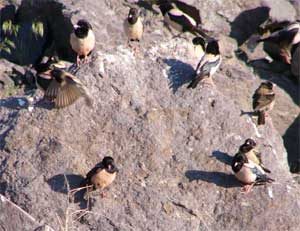
Rose-coloured Starlings
At various spots around the many lakes of the area we added Dalmatian and Great White Pelicans, Garganey (a very common duck here), Red-crested Pochard, Little Ringed Plover, 23 Terek Sandpipers, Temminck's Stint, Caspian Gull, White-winged Tern, Oriental, Sky, Greater Short-toed, Lesser Short-toed, Crested and Calandra Larks, Hoopoe and Red-headed Bunting.
A search of a small wood yielded Barred Warbler and Blyth's Reed-warbler and nearby we found a male Red-backed Shrike. There were some areas of reedbed and although relatively small, held singing Great Reed-warblers. We saw several perched up singing on the reeds very well before a Western Marsh-harrier decided to drop in! Our packed lunch was consumed at another large lake where we picked up some more new species: Little Bittern, Great Egret, Little Tern, Common Kingfisher, Black-headed Wagtail and Sykes's Warbler whilst the House Sparrows here were of the bactrianus race. These birds are highly migratory and are a potential split from House Sparrow. Next, we stopped at small woodland to search for Shikra. First we picked up a circling Black Stork and then a Long-legged Buzzard before the Shikra appeared and showed extremely well. Moving away from the lakes, we continued our journey finding Pied and Isabelline Wheatears, Spotted Flycatcher, Isabelline and Lesser Grey Shrikes, Tree Sparrow and the halimodendri race of Lesser Whitethroat at a roadside stop.
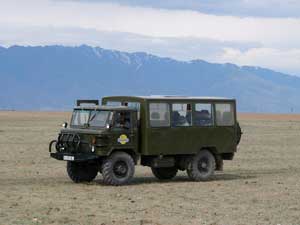
Heavy-duty transportation
After an excellent day, we headed for our camp from the main road across the Taukum Desert. Shortly after leaving the road, we came across a group of 12 Greater Sandplovers, the males in full summer plumage. At a small waterhole near the camp we picked up Temminck's Stint, Lesser and Greater Short-toed Larks, Isabelline Wheatear and two Ruddy Shelduck. Four Black-bellied Sandgrouse flew past as did a single Greater Sandplover and we found a pair of Red-headed Buntings. Finally, a pair of Demoiselle Cranes were 'scoped' in the fading light. Our camp was amazing with everyone being assigned their own Yurt (traditional Kazak nomads accommodation) complete with electric lights, power points, beds and carpets! Outside each Yurt was a washbasin and the toilets and showers were in little tents and we even had hot water in the showers! The dining tent was huge and the food remarkably good, we were certainly not roughing it!
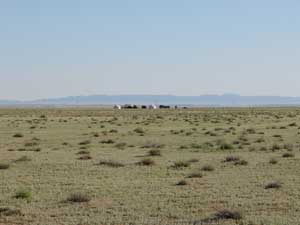
The camp in the Takum Desert – larks were abundant
Today we drove into the desert, stopping and scanning every so often. Soon, we were watching a fine, displaying male Macqueen's Bustard. During the morning we saw seven of these magnificent birds, displaying, standing and flying. Four Black-bellied Sandgrouse were watched as they sat on the ground and we found migrants in the form of Spotted Flycatcher and Blyth's Reed-warbler. Various stops to scan specific vegetation soon added a pair of superb Caspian Plovers – a highlight of the trip for many. We next stopped at a ruined house that had the only tree for literally miles around. In this tree were nesting House (Bactrian) and Spanish Sparrows. The area also added our first Bimaculated Larks and a Steppe Grey Shrike (Lanius meridionalis pallidirostris). Lesser Whitethroats and Syke's Warblers were again seen as were three Horsefield's Tortoises and a young Persian Gazelle (now very rare and difficult to see).
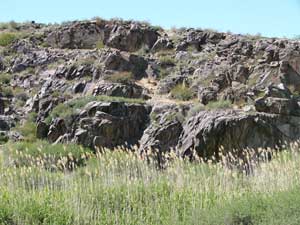
Rocky habitat – home to a pair of Eastern Rock Nuthatches
The afternoon was spent at a rocky canyon with ancient petroglyphs. En route we picked up the 'usual' common larks plus White-winged Lark which occasionally breeds in the area and Hoopoe and Eurasian Hobby. Arriving at the canyon, Red-headed Buntings showed well together with two male Grey-necked Buntings whilst the rocky slopes were home to Chukars and Pied Wheatears. Our main target bird was Eastern Rock Nuthatch and it didn't take too long to find complete with its amazing nest. Both Isabelline and Red-backed Shrikes were also seen together with a soaring Golden Eagle but the grand finale was saved until just before we left with two Desert Finches coming down to drink. On the way back to the camp we found more White-winged Larks, bringing our total up to an incredible eight. After dinner at the camp, a few of the group were fortunate to see a European Nightjar flying through the camp.
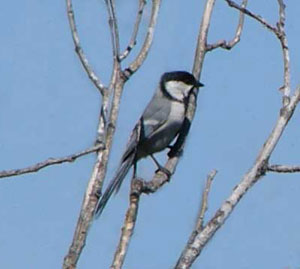
Turkestan Tit
Sadly leaving camp, we drove to an area known as the Barkhans, rolling scrub-covered sand dunes interspersed with small lakes closer to Lake Balkhash. Mike's shout of 'Eagle Owl' had quickly stopped the bus and clambering over the first hill where we admired two huge Eurasian Eagle-owls flying slowly over the desert, mobbed by Brown-necked Ravens. They then perched on bushes a few hundred yards away glaring at us for disturbing them! The first lakes held Red-crested Pochard, Ferruginous Duck and Black-winged Stilt whilst the bushes and reeds held the large-billed pyrrhuloides race Common Reed Buntings looking very pale on the back, plus 'Caspian' Common Reed-warblers and Cetti's Warbler.
At our second stop, we added two Azure Tits, the Siberian race of Common Starling, Grey Heron, Great Bittern in flight, Shikra and a group of seven Eurasian Honey-buzzards soaring overhead. Our target here was Black-headed Penduline-tit but we could only find White-crowned Penduline-tit, albeit incredibly close views. This area used to be a good site for Black-headed Penduline-tit but it seemed that the White-crowneds had pushed them out. Nearby trees held at least eight Eurasian Golden Orioles, White-winged Woodpecker, Common Nightingales and a pair of breeding Turkestan Tits.
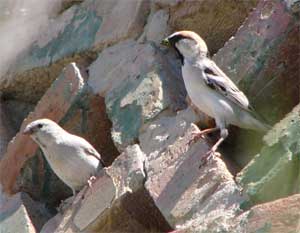
Saxaul Sparrows
Rob suggested a stop further on, at another reed bed. This proved an excellent idea as we saw a close female Black-headed Penduline-tit here – a very nice looking bird. Driving on, we stopped at a small patch of woodland comprising endemic turanga trees. Here we again saw White-winged Woodpecker and Turkestan Tit whilst we added the highly sought-after Eversmann's Dove to the list. After lunch in the woods we drove over the Ile River, stooping on the bridge to admire two Citrine Wagtails, and on to a Muslim cemetery situated in an area of bushes and small trees in another part of the desert. Here we added European Turtle-dove to the list as we walked to the cemetery where we were soon watching our target species, Saxaul Sparrow, nesting in the mausoleums alongside Eurasian Tree Sparrows. In the surrounding bushes we found several other good species: Pied Wheatear, Sykes's and Asian Desert Warblers and singing in the open almost together, Common Nightingale and Rufous Bush-robin. We arrived back to our hotel in Almaty early evening and a few people saw European Scops-owl after dinner. Much rarer however, a Tawny Owl was heard calling in the grounds.

